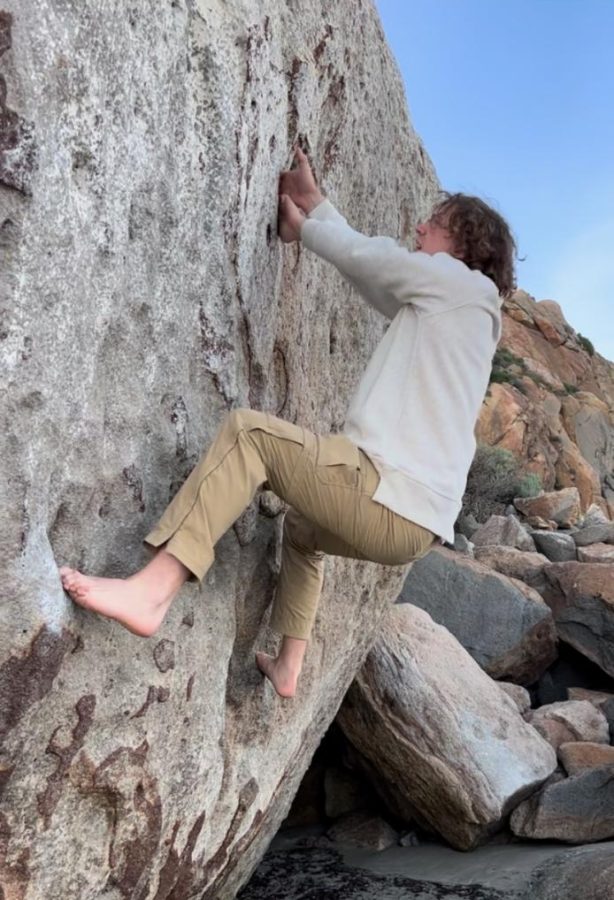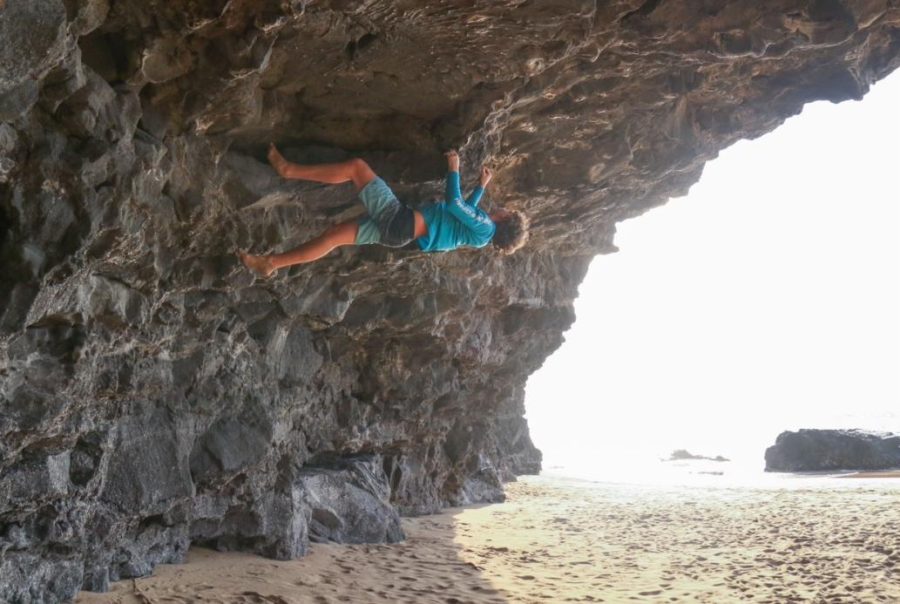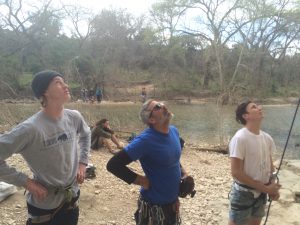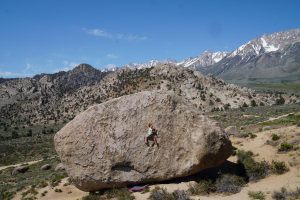Kuhlken rocks the wall
Senior takes passion for outdoor climbing to new heights
Senior Ethan Kuhlken hangs from a rock during a party on a beach in Hawaii. “I had wandered onto the beach and found a cave in the rock,” Kuhlken said. “I got a very strong urge to climb up the edge so I just started looking at my route and climbing. I felt very free and it was liberating, but it was so unsafe.”
May 30, 2023
The first thing senior Ethan Kuhlken looks for when approaching a new climb is the path his hands will take up the wall.
To Kuhlken, climbing is like solving a puzzle, and must be approached as such. So he plans out his path before he begins. He looks at each of the holds on the wall and considers how best to shape his hand on each one.
“That’s usually the hardest because you have to figure out how to land on each hold and how to cross your arms over [each other],” Kuhlken said. “It’s a pretty complex problem.”
Once that’s solved, he considers where to place his feet on the wall to follow his hands. Then, he’s ready to attempt the climb.
“I usually go up [to the wall] and feel the holds, because you can’t tell exactly how your hand will fit on it until you’ve touched it,” Kuhlken said. “I get chalk on my hands, and just try it once. Then I start trying it over and over again, refining it.”
Kuhlken has been refining his technique since he first started bouldering, or free climbing on artificial rock walls, three years ago. He’s one of many to hop on the trend; the sport’s popularity is seemingly ever-increasing. But Kuhlken’s not your average climber. While he’s no stranger to the climbing gym, Kuhlken has taken his climbing to the next level. Or rather, the next location.
“[My friend and I] would go climb at ABP [Austin Bouldering Project] and we got really into it, so we got memberships and started climbing indoors a lot,” Kuhlken said. “Then, I was like, ‘Hey, most people climb indoors. We should go climb real rocks.’”
Kuhlken not only transitioned out of the gym and into the wild but to a new form of climbing: deep water soloing, in which climbers scale cliffs over a body of water and fall into it once they’ve reached the top.
“You fall into the water and don’t have to worry about a rope,” Kuhlken said. “That was really fun. Definitely my favorite form of climbing.”

Not only do indoor and deep water climbing pose differences in technique, but they also set different challenges. Deep water climbs are much higher. While you generally climb around 20 feet and fall onto a pad when bouldering, deep water climbs can range from 40 to 50 feet. Especially at Pace Bend Park, where Kuhlken often climbs.
“When you get up there, you’re super tired,” Kuhlken said. “Your arms are shaking. You can’t really hold the rock anymore. And, to jump back, all your muscles are just depleted, kind of cramping. You’re falling far into the water, and you’re like, ‘I’m going to die. This is scary.’ You let out lots of screams. If you get [to the top], then you have to turn around and see that you’re jumping off the cliff to get to water.”
Despite the dangers of deep water soloing, Kuhlken isn’t deterred. To him, the benefits of outdoor climbing outweigh the risks.
“I love rocks,” Kuhlken said. “I really like being outside. So I like it more [than indoor climbing]. But it’s definitely a shock when you think you’re really good because you don’t have the route laid out for you. You don’t have all the holes in a specific color to see where you’re going. You don’t know where you’re going. The rock could be wet. So you have to kind of be able to adapt. If you reach for a rock and it’s wet, you may have to just fall.”
Kuhlken noted that bouldering indoors is much more controlled. In the gym, there are fewer variables, and thus less risk.
“You have to be really careful outside because when you’re bouldering, you need to have somebody moving a pad for you and watching for you and kind of spotting you,” Kuhlken said. “You want to always have a pretty controlled fall [outside], but in the gym, you can manage to have a less controlled fall. So, outside, there’s a lot less dynamic climbing, big movements and jumps. But just being outside with the wind and the sun, and climbing with friends on an actual rock is really fun.”
Although outdoor climbing requires Kuhlken to think more critically, that’s precisely what he loves about climbing.
“It’s different from any sport I’ve tried,” Kuhlken said. “The entire sport is based around problem solving and refinement, taking less and less time to do certain things and being more and more precise in your movements.”
Climbing isn’t only a good workout or a good way to pass the time; it has also helped Kuhlken sharpen his thinking patterns.
“I have learned to take in information really quick to process it and figure out how I’m going to place myself on the wall,” Kuhlken said. “There’s some physics to it because you kind of have to know how your body will swing and how your body will move on the wall. You should know, like, ‘When I grab that hold with that hand at that angle, my body will move in this way and these muscles will be used.’ You have to get very, very specific in your planning.”
Kuhlken can put the critical-thinking skills climbing has given him to use as he prepares to take on the next phase of his life. He will attend UC Santa Cruz next year to double major in cognitive science and classical guitar. Santa Cruz also has a vibrant climbing community. So all of Kuhlken’s bases are covered.
“I went and bouldered around [while visiting],” Kuhlken said. “Every single rock that is taller than 15 feet is covered in chalk marks from people climbing. There are so many climbers; I bet half the people in that entire town climb or more.”
Perhaps the climbers of Santa Cruz could ease Kuhlken’s transition to college life. Because that’s another thing he loves about climbing: how supportive and welcoming everyone is.
“It’s a really good community,” Kuhlken said. “I’d say probably about half my friends have come from climbing. It’s a very tight-knit and pretty friendly community. Even if you don’t know everybody at the gym, most people would be fine to just talk and hang out. You can kind of just talk to anyone.”
It doesn’t matter whether he’s 40 feet high on a cliff at Pace Bend or on the wall at ABP. As long as he’s climbing, Kuhlken feels at peace.
“I feel very at home while climbing,” Kuhlken said. “I just feel like I belong there, at a wall, climbing. I have such a great community around it. It just makes me really happy. It always is a way to brighten my day. If I’m having a bad day, I just go climb.”








